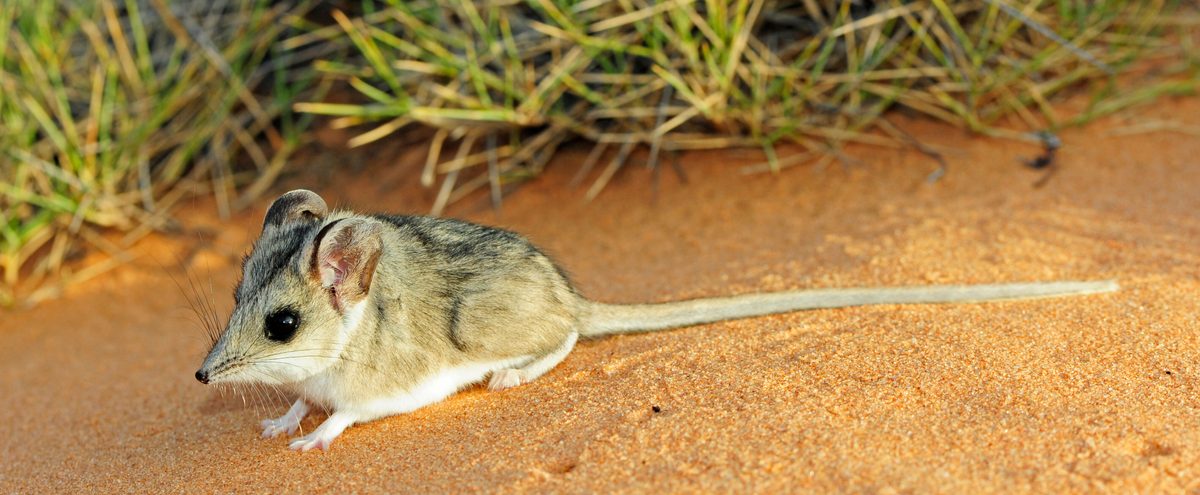
Sandhill dunnarts
The sandhill dunnart (Sminthopsis psammophila) is small carnivorous marsupial, usually 10-16cm long and weighing 30-44g. They have large ears and thick tails where they store fat. Sandhill dunnarts can be distinguished from other dunnart species by the dark 'brush' of fur that runs along the underside of their tail.
One of the largest and rarest dunnarts, it is listed as “vulnerable” under the Environment Protection and Biodiversity Conservation Act 1999. In the AW region it is considered that the greatest causes of the population decline are predation by introduced species such as foxes and cats, habitat degradation and wildfire.
During the day they sleep in burrows in the sand, emerging at night to hunt insects, arachnids and small reptiles. They dart between clumps of spinifex, relying on the spiky plants to protect them from predators.
Sandhill dunnarts are an elusive species that are only known to live in a few locations within Australia. These include the Middleback Ranges on the Eyre Peninsula, Queen Victoria Spring Nature Reserve in Western Australia and throughout western Yellabinna Regional Reserve within the Alinytjara Wiluṟara (AW) region of South Australia.
In the AW Landscape region they have been recorded within three distinct areas: Yarle Lakes, north-west of Ooldea; the Immarna and Iluka region approx. 140 km east of Ooldea along the Trans Australian Railway line with the next closest recorded around Pinkawillinie, approximately 400 km away.

Aside from annual surveys undertaken by AW across these areas, similar research is also carried out to try to locate other populations that might inhabit suitable habitat between these known sites. Sandhill dunnarts are known to prefer areas where fire most recently burned between 20-40 years ago. On this basis the most appropriate survey sites are selected with reference to detailed fire scar maps. This 20-40 year time frame allows spinifex grass (Triodia) to gain a suitable density, height and depth, to provide the dunnarts refuge from introduced and native predators.
In April 2017, a young female sandhill dunnart was captured in the survey area where fire was last recorded in 1988, indicating that the species is more widely distributed within Yellabinna than previously recorded.
Subsequent surveys have confirmed the presence of the sandhill dunnart in multiple locations within the Yellabinna Wilderness Protection Area, with a young female captured in a survey held near Mt Finke in May 2022.
A survey in 2023 further expanded known sandhill dunnart habitat, locating the animals further south than ever before, just 50km north of Ceduna.
Multiple surveys have included measurement of the size and spacing of the spinifex where dunnarts are found, refining our understanding of their preferred habitat. A video summarising the 2022 survey can be seen above.
These surveys are funded through the Australian Government’s National Landcare Program.
In 2024 a pitfall trapping survey took place near Googs Lake, with rangers from the Far West Coast Aboriginal Corporation. A group of Year 12 students from Ceduna Area School also joined the crew, assisting with checking the traps and packing up the pitlines at the end of the week.
The video above shows sandhill dunnarts captured during that survey being released. The survey also recorded several western pygmy possums. See them being released in the video below.
Fauna surveys in 2025 reflected the drought conditions across most of the region, with lower numbers of mammals recorded in surveys in the APY Lands, Yumbarra and Immarna. In spite of the dry conditions, the surveys did record six species of dunnart – Ooldea dunnart (Sminthopsis
ooldea), hairy-footed dunnart (Sminthopsis hirtipes), fat-tailed dunnart (Sminthopsis crassicaudata), little long-tailed dunnart (Sminthopsis dolichura), lesser hairy-footed dunnart (Sminthopsis youngsoni), and the sandhill dunnart.
